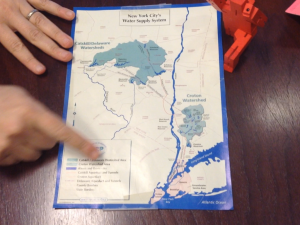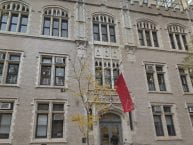
A map of New York City’s Water Supply System
On Thursday, December 11, my group and I were lucky enough to interview Hillary Meltzer, the Deputy Chief of Environmental Law who often works with groups like the DEP (Department of Environmental Protection) and Parks and Recreation Department. Her office is at 100 Church Street, on the 6th floor. We had to show our student I.D.s, then when we reached the 6th floor we were met by Hillary Meltzer who led us through the maze of halls and to her office. She often works with the DEP, and so has a lot of knowledge on the environment, specifically on how water is treated in New York City.
Hillary started with talking about the Hudson River. She said that the Hudson River was increasingly polluted throughout the 18th and 19th centuries, and by the 19th century it was so polluted that it was the source of major disease outbreaks, such as cholera and typhoid. Because there was so little available water, the city was vulnerable to fires, which destroyed huge parts of the developed areas of lower Manhattan.
It was in the 1830’s that the government created the city’s first upstate water supply. They built a dam on the Croton River and built a 25 mile aqueduct from Westchester to supply water to the city. We still use an aqueduct, but a new one, to carry water from there to the city. As the population grew we needed a larger amount water and so we built more supplies, now mainly from over the Hudson River. The Croton River is on the East side of the Hudson River, and starting in the 19th century we built more on the west side. Four were built to the west, including two in the Catskills and some in Delaware.
Hillary went on to explain how there is no pumping required in the water system because of gravity. The reservoirs are in a higher elevation then the city, so the potential energy they get from coming down is even enough to pump it up to the 6th or 7th floors of buildings. This is a great system because it does not require pumping facilities, making it cheaper, and more environmentally sound because there are no harmful emission coming from pumping.
She also talked about how, throughout human history, we’ve disregarded what we’re putting in the water and have just taken it for granted as a convenient place to dump trash and other waste. In the 1960s and 70s we realized that the pollution we were making was causing our rivers and bodies of water to become incredibly toxic. This caused bodies of water such as the Cuyahoga River in Ohio that caught fire multiple times, and other waterways such as the Gowanus Canal to become incredibly polluted. In 1972 the Federal Clean Water Act was passed, which essentially said that you could no longer dump everything in any. This caused the need for water treatment plants, which were used to clean water polluted in industrialization before dumping it into waterways, which meant that factories and such had to clean and treat the water they dumped.
She went on to talk about other topics such as storm water runoff, sewer systems, and showed us a presentation about water quality.





